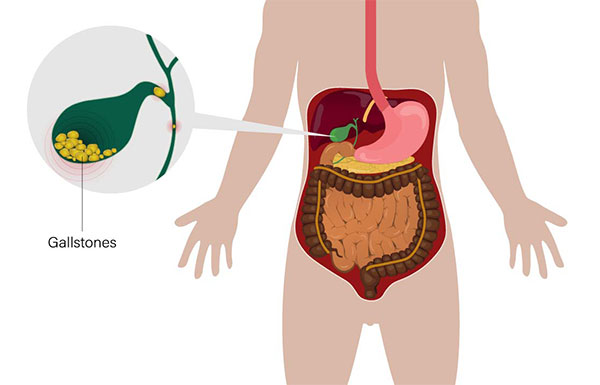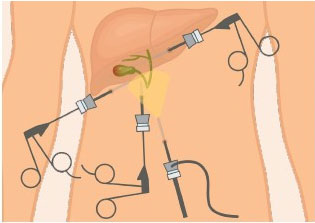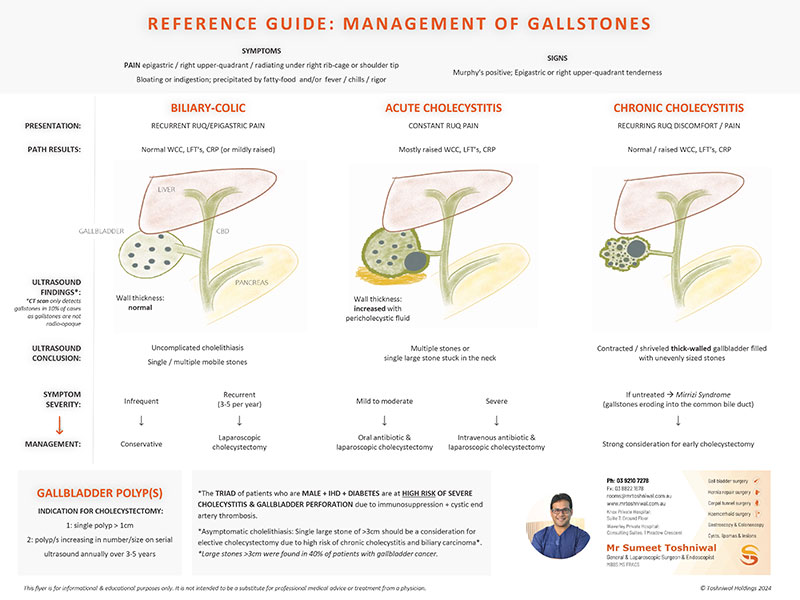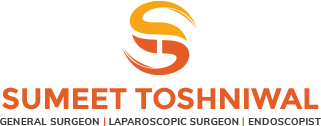
Gallbladder / Lap Chole:
Have you just experiences pain under your right rib cage or just under your breast bone?
Is the pain going towards your back or the right shoulder tip?
For women who have had natural births, is it worse than childbirth?
Do you also get associated bloating, wind, especially after eating fatty foods like cheese & crackers?
If you have any of these symptoms or a few of these, there is a strong change you may have gallstones. You should see your GP.
Gallstones is a very common problem with 1 in 10 adults having gallstones. Anyone can get gallstones however there are certain conditions/circumstances that make you more prone to getting them:
- Pregnancy
- Overweight
- Rapid weight loss
Not everyone experiences problems, symptoms, or pain with gallstones but for those when it starts causing problems, the best and most common way to manage this is with keyhole surgery, laparoscopic cholecystectomy. It is the gold standard of care with symptomatic gallstones.
But before we go in to the details of surgery, let’s first understand what are gallstones and what does the gallbladder do?
What does the gallbladder do?
The gallbladder helps concentrate bile secreted by the liver.
What is bile?
In laymen terms bile is like a detergent piqued that helps in cleaning oil from dishes, likewise bile aids in digestion of fat.
Inadequate bile or improper function of the gallbladder can result in indigestion of fat with symptoms of bloating, fullness, and pain usually in the upper abdomen or below the right rib cage radiating to the back or in between shoulder blades or right shoulder tip.
What are gallstones?
Gallstones are stones mainly primarily made of cholesterol and bile deposited in the gallbladder, getting crystallised. Gallstones can be of varying size from very small, like sand, often called sludge, to pea size (most common) to mulberry size all the way up to the size of an avocado seed (rare).
Depending on the number and size of the stones they can cause symptoms from mild pain to severe pain (worse than labour pain) to getting very sick with pancreatitis.
Once you have been diagnosed with gallstones, it is advisable that you consult a surgeon who does gallbladder surgery regularly to understand your condition better.
Can I choose not to have my gallbladder removed?
Of course! Apart from certain definite indication where a delay in operation can lead to an adverse outcome most gallbladder attacks can be managed with pain relief for a variable amount of time.
Can I have my gallstones dissolved?
Although historically gallstones are known to pass through the intestine and can be dissolved, the biggest risk it carries is of pancreatitis. When you consult a naturopath or take gallstone dissolving medications you must ask your naturopath the risk of pancreatitis as pancreatitis can be quite serious with extreme cases landing the patient in the Intensive Care Unit (ICU).
What happens if I don’t have my gallbladder?
Your liver is still producing bile except that it is not getting concentrated. In a way it is better because your gallbladder was not functioning well and was resulting in interrupted flow of bile and also associated pain and indigestion.
What happens when I go to my GP with suspected gallstones?
Your GP should order an abdominal ultrasound which is the gold standard for detecting gallstones.
CT scans are not as good at picking up gallstones as 90% of stones do not have calcium in them and are therefore not radio-opaque to be picked up by the CT scan.
Your US report may reveal:
- Multiple stones of varying sizes
- Single large stone of 1cm or bigger in the neck of gallbladder
While symptoms can vary & so can the frequency of attacks the most definitive treatment for gallstones is a key hole operation to get the gallbladder out called a laparoscopic cholecystectomy.
The need and timing of the operation is best determined by seeing your surgeon, however an earlier operation should be strongly considered in the following situations:
- 6mm stones / sludge – as these can pass through the gallbladder to the Common Bile Duct and cause Pancreatitis.
- Recurrent biliary colic – 3-5 attacks per year. This many attacks per year means the gallstones are likely to cause complications which includes infection (cholecystitis) acute or chronic.
- Single large stone impacted in the neck of gallbladder – this can completely block the flow of bile & can result in bile getting infected, called empyema of the gallbladder. This condition can make you very sick with fever/chills & rigors & in some cases jaundice.
- Patients who are diabetic. Diabetic patients are very high risk as infections take time to manifest & patient can get very sick before they feel any pain. The sugars also go haywire. An earlier operation is highly recommended in this category.
- Recurrent pain (biliary colic) during pregnancy. While most patients get through pregnancy, in a minority of cases the patient may need their gallbladder out, for which 2nd trimester is the best.
Gallbladder surgery
Commonly done laparoscopically / keyhole with four small incisions.

The aim of the surgery is to take the gallbladder out safely without damaging any surrounding structure of which the most important is the Common Bile Duct (CBD).
Surgeons take every precaution to make sure that this does not happen and overall incidence is extremely low <0.5%.
However delayed surgery with a lot of inflammation can make the operation harder and increase the risk.
During the operation we also make sure that there is no stone in the common bile duct (CBD) by doing an xray on table called an Intra-operative Cholangiogram (IOC).
If a stone is found then it will need an additional procedure called an Endoscopic retrograde Cholangiopancreatography (ERCP). The ERCP is an endoscopy to remove the stone.
Average duration of surgery is approximately 30 minutes to 1 hour.
Most patients go home the next day but in selected cases it can be done as a day case.
Occasionally if the operation has been difficult patient will notice that a straw-like catheter is coming out. This is a drain tube to drain any additional fluid or blood that may collect in the abdomen.
What can I expect after gallbladder surgery?
You will have four dressings covering the incision sites.
Care of Wound:
- Clear plastic dressings can be left in place for 4 days. These are waterproof and you may shower as normal. After 4 days fresh dressings need only be applied if the wound is weeping or the skin has not yet completely closed. Please remove and apply fresh dressings as needed
- Please change your dressings if they get wet or become smelly. Call the rooms for advice if unsure about what to do
- After 4 days when the wounds have closed leave them open to the air to promote healing. If preferred you may cover with Band-Aids, changed as needed, until healed
- If you experience any problems with your wound, including abnormal redness, pain, smell, or discharge please call our rooms
- Any sutures will be removed at your follow-up appointment (unless dissolvable)
- Some bruising and swelling around the wound and abdomen is normal
Please note- Within 24 hours of your Operation You Should Not:
- Drive a car or take public transport unaccompanied
- Operate Machinery or Consume alcohol
- Sign any legal documents or make any responsible decisions
Analgesia:
Shoulder tip pain is common post-operatively because of the gas used during the operation. Usually this will resolve by itself within 24-48 hours.
- Take Paracetamol 2 Tabs 4-6 hourly if required
- Stronger analgesia such as Endone or Tramadol may be prescribed and can be taken if needed as per instructions for the first few days
- Do not drive or operate machinery if taking prescribed medication
Diet:
- There are no dietary restrictions. Aim to eat nourishing, healthy foods. It is also recommended to limit fat intake post-operatively
- To avoid post-operative constipation please increase fluid and fibre intake
- Laparoscopic Cholecystectomy patients may occasionally experience loose motions which resolves spontaneously
Activity:
- Estimated recommended time off for recovery (depending on nature of work): 2 weeks
- Avoid lifting heavy objects greater than 15kgs or engage in vigorous exercise for a period of 4 weeks
- Slowly increase your activity levels over this time. Light housework and gardening may be undertaken if no discomfort
- You may drive your car when you feel confident and safe to do so
On-going Care:
- Attend your post-operative appointment that will be made for you prior to discharge from Hospital. If you do not have a post-operative appointment booked prior to discharge please call our Rooms on 9210 7278 to arrange one
- Please call our rooms if any of the following occur:
- If you experience any problems with your wound, including abnormal redness, pain, smell or discharge
- You develop a fever, or get hot/cold flushes
- Your pain is not being relieved by the analgesia you are using
- If after-hours call your GP or for urgent matters after-hours present to the Emergency Department & notify our rooms during business hours on the following business day

Cholecystectomy
The gallbladder is a small pear-shaped storage organ located under the liver on the right side of the abdomen. It stores bile (yellowish-brown fluid) produced by the liver, which is required to digest fat. As food enters the small intestine, cholecystokinin (a hormone) is released, which signals the contraction of the gallbladder to release bile into the small intestine through the common bile duct (a small tube connecting liver and intestine).
Gallstones
Gallstones are hard deposits of digestive fluid (bile) that develop in the gallbladder (a small, pear-shaped organ located on the right side of the abdomen just below the liver). Gallstones may be as small as grain of sand to as big as a golf ball.
Gallbladder Dysfunction
Cholecystitis is inflammation of the gallbladder. The gallbladder is a pear-shaped organ which lies just below the liver. The gallbladder stores bile, a digestive fluid that is sent from the liver. Most cases of cholecystitis are caused by gallstones. Gallstones are crystalline structures that develop in the gallbladder or the bile ducts and can interfere with the normal flow of bile leading to inflammation. Other less common causes include injury to the gallbladder due to trauma or surgery, infection or tumours.
Laparoscopic Cholecystectomy
The gallbladder is a small pear-shaped storage organ located under the liver on the right side of the abdomen. It stores bile (yellowish-brown fluid) produced by the liver, which is required to digest fat. As food enters the small intestine, cholecystokinin (a hormone) is released, which signals the contraction of the gallbladder to release bile into the small intestine through the common bile duct (a small tube connecting liver and intestine).
